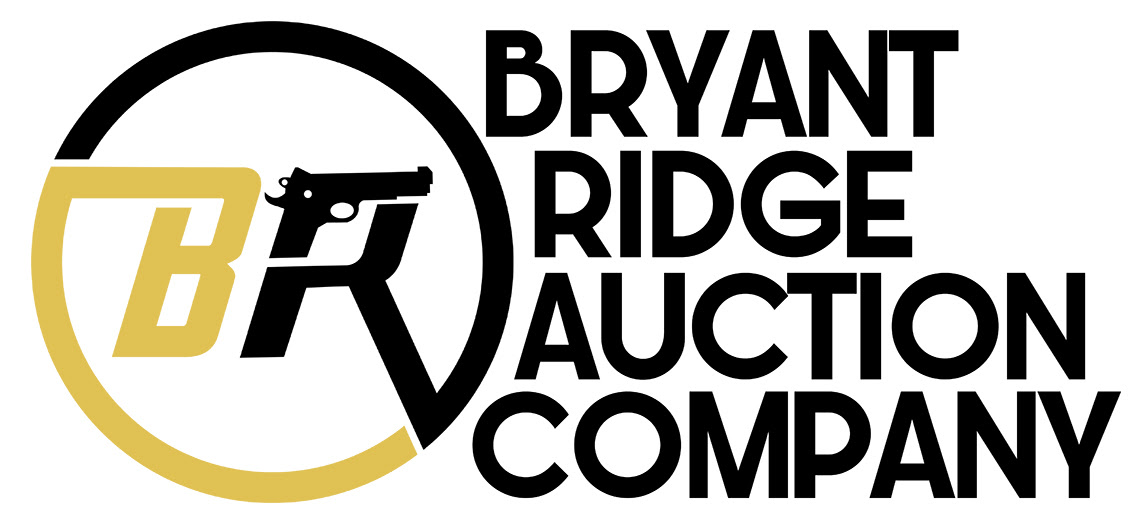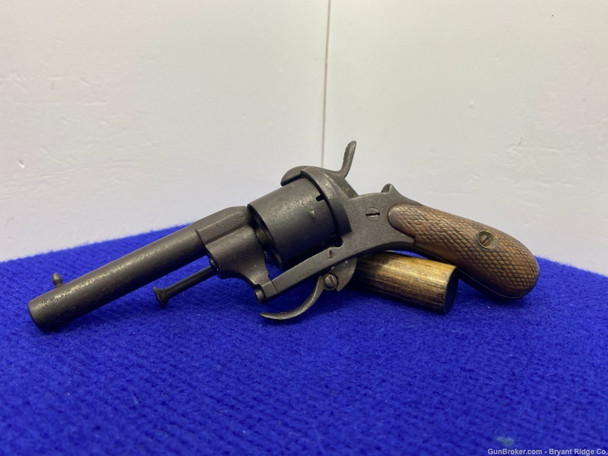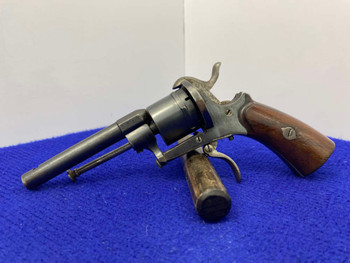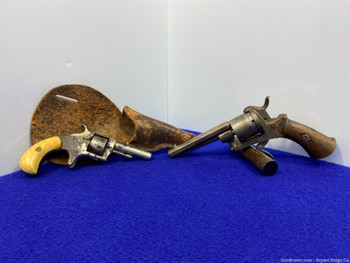Description

Item Description
Bryant Ridge Auction Company is pleased to present this unique revolver today for a penny start auction, this is the Lefaucheux Style Pinfire Revolver!
SPECIFICATIONS:
Manufacturer: Belgian
Model: Lefaucheux Style Pinfire
Serial: No Serial
Date of Manufacture: Circa 1832-1880
Caliber: ~8mm Pinfire
Finish: Patina
Barrel Length: 3.25"
Optics/Sights: Post front with hammer notched rear
Stock/Grips: Checkered Wood
Action: DA/SA Pin Fire
Markings: None
Bryant Ridge's Analysis:
Casimir Lefaucheux (26 January 1802 – 9 August 1852) was a French gunsmith. He was born in Bonnétable, France and died in Paris, France. Casimir Lefaucheux obtained his first patent in 1827. In 1832, he completed a drop-barrel sporting gun with paper-cased cartridges. Lefaucheux is credited with the development of one of the first efficient self-contained cartridge systems. This 1835 invention, featuring a pinfire mechanism, followed the pioneering work of Jean Samuel Pauly in 1808-1812. The Lefaucheux cartridge had a conical bullet, a cardboard powder tube, and a copper base that incorporated a primer pellet. Lefaucheux thus proposed one of the first practical breech-loading weapons.
In 1846, Benjamin Houllier improved on the Lefaucheux system by introducing an entirely metallic cartridge of copper brass. The pin-fire (or pinfire) is an obsolete type of is a type of metallic cartridge used in firearms, where the priming compound is ignited by striking a small pin that protrudes radially from above the base of the cartridge. Invented by Frenchman Casimir Lefaucheux in 1832, but not patented until 1835, it was one of the earliest practical designs of a metallic cartridge to hasten the loading and firing process of a firearm. Its history is closely associated with the development of the breechloader, which would eventually replace all muzzle-loading firearms.
The cartridge featured a small pin that, when struck, would ignite the priming compound and initiate the firing process. Despite initial resistance, especially from British gun users, the pinfire cartridge gained popularity following the Great Exhibition of 1851. Its advantages included easier and faster loading than percussion weapons, and it was more likely to fire reliably when wet. However, with the introduction of reliable rimfire and centerfire cartridges, which were quicker to load and safer, the pinfire cartridge became obsolete. Today, enthusiasts of vintage weaponry often create pinfire cartridges from modern materials for use in antique firearms.
Return Policy:
We gladly offer a 3 day unfired inspection policy from the time that the firearm is delivered to your FFL. Refunds are available for all qualifying orders.
Model: Lefaucheux Style Pinfire
Serial: No Serial
Date of Manufacture: Circa 1832-1880
Caliber: ~8mm Pinfire
Finish: Patina
Barrel Length: 3.25"
Optics/Sights: Post front with hammer notched rear
Stock/Grips: Checkered Wood
Action: DA/SA Pin Fire
Markings: None
Bryant Ridge's Analysis:
Casimir Lefaucheux (26 January 1802 – 9 August 1852) was a French gunsmith. He was born in Bonnétable, France and died in Paris, France. Casimir Lefaucheux obtained his first patent in 1827. In 1832, he completed a drop-barrel sporting gun with paper-cased cartridges. Lefaucheux is credited with the development of one of the first efficient self-contained cartridge systems. This 1835 invention, featuring a pinfire mechanism, followed the pioneering work of Jean Samuel Pauly in 1808-1812. The Lefaucheux cartridge had a conical bullet, a cardboard powder tube, and a copper base that incorporated a primer pellet. Lefaucheux thus proposed one of the first practical breech-loading weapons.
In 1846, Benjamin Houllier improved on the Lefaucheux system by introducing an entirely metallic cartridge of copper brass. The pin-fire (or pinfire) is an obsolete type of is a type of metallic cartridge used in firearms, where the priming compound is ignited by striking a small pin that protrudes radially from above the base of the cartridge. Invented by Frenchman Casimir Lefaucheux in 1832, but not patented until 1835, it was one of the earliest practical designs of a metallic cartridge to hasten the loading and firing process of a firearm. Its history is closely associated with the development of the breechloader, which would eventually replace all muzzle-loading firearms.
The cartridge featured a small pin that, when struck, would ignite the priming compound and initiate the firing process. Despite initial resistance, especially from British gun users, the pinfire cartridge gained popularity following the Great Exhibition of 1851. Its advantages included easier and faster loading than percussion weapons, and it was more likely to fire reliably when wet. However, with the introduction of reliable rimfire and centerfire cartridges, which were quicker to load and safer, the pinfire cartridge became obsolete. Today, enthusiasts of vintage weaponry often create pinfire cartridges from modern materials for use in antique firearms.
Return Policy:
We gladly offer a 3 day unfired inspection policy from the time that the firearm is delivered to your FFL. Refunds are available for all qualifying orders.
















